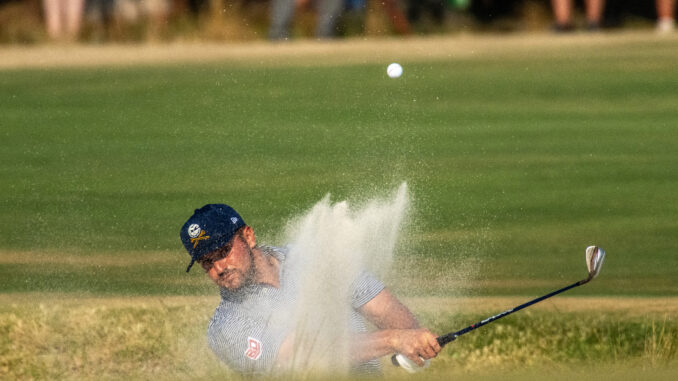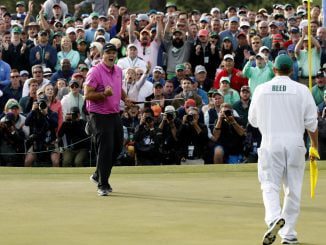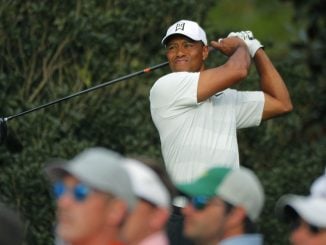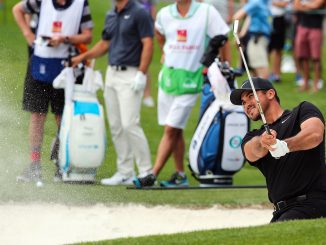
Entering the week, Bryson DeChambeau was hoping to avoid drama at a Pinehurst No. 2 course that was capable of causing plenty of it.
“If I get my irons in a place where I’m hitting it in the middle of the greens and just playing boring golf, that’s the goal for me this week is try to play as boring a golf as possible,” he said.
On the 18th hole, however, things got exciting, and that was bad news for his quest to win a second U.S. Open.
The 2020 U.S. Open champion opened the day with a three-stroke lead, but Rory McIlroy made a run, putting the pressure on by trimming that lead to one. DeChambeau actually could have been in a position of chasing McIlroy on 18, but some bad luck of his own—a missed putt on 16—kept McIlroy from pulling ahead.
When DeChambeau teed off on 18, he was tied with McIlroy, who was on the green at the same hole. That’s when the excitement began.
His tee shot hooked far left, deep into the rough, forcing course workers to pick up their bags and move out of the way. The ball landed in a nest of TV cables and roots. The cables were moved out of the way, leaving just one obstacle.
“I was actually concerned I might hurt myself getting out of that,” DeChambeau said. “I was trying to get TIO relief (Temporary Immovable Obstructions, allowing him to move his ball), but didn’t have anything in my way, unfortunately.”
By that point, McIlroy had missed another short putt, meaning DeChambeau now knew that par would win him the tournament. Of course, he’d already used one of his four shots, and his position looked bleak.
DeChambeau came up with a plan.
“I was trying to run it left of that bunker,” he said. “Run it up the green, give myself a 2-putt. I had no backswing. At a certain point in time, I’m just like, ‘Okay, I have to hack it; hopefully it will go down the line.’”
It didn’t.
“It cut, and it went into the bunker,” he said.
Two shots down. Two to go, and DeChambeau was in the sand trap, more than 56 yards from the hole.
“One of the worst places I could have been,” he said.
It wasn’t the first time during the week at Pinehurst that DeChambeau had encountered adversity. He lost his yardage book prior to Thursday’s first round.
“Everything,” he said of the book’s contents. “All the secrets.”
“Must have fallen out when I got out (of the car),” he said.
He relied on the notes taken by his caddy, Greg Bodine, until course officials were able to find and return his book.
Then, on Saturday morning, he woke up with pain in his hip, DeChambeau tried to play though it, but after 10 holes, he had to call in reinforcements, getting a brief mid-round therapy treatment session in a wooded area. He responded with a birdie on 11 and finished the round as the man to beat going into the final day.
Losing his notes and fighting through tightness in his hip were nothing compared to the trouble he’d created for himself on 18, however. A bogey would send the Open to a playoff.
Once again, when trouble began, Bodine was there to step up to give DeChambeau an assist.
“G-Bo just said, ‘Bryson, just get it up-and-down,’” DeChambeau recalled. “’You can do it.’ Greg telling me, ‘You got this shot. I’ve seen way harder shots pulled off from you.’ … I said, ‘You’re right. I need a 55-degree (wedge). Let’s do it.’”
Then came the shot that will take its place in golf lore. From out of a spray of sand in the bunker, onto the green, to within four yards of the hole. A 55-yard shot that left him with a short putt to save par and take home the trophy.
It turns out that, as much as he preaches the need to play boring, down the middle golf, when things go wrong, Bryson DeChambeau finds himself in his own personal briar patch—where he was born and raised.
“I go back to being a kid,” he said. “When I was a kid, I used to throw golf balls in the worst lies outside of the fairway and just learned to hit out of the worst situations to see what I could do. That sparked a lot of my creativity. But then I’d go back and work on the mechanics really hard. I had this unique childhood experience in golf of working on really quirky, weird things, then also working super hard on the mechanics, trying to be as machinelike as possible. I feel like that combination allows — it just pretty much shows what I did today.”
And all he did on that Sunday in Pinehurst was make history.
“That bunker shot was the shot of my life,” he said.



